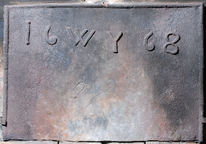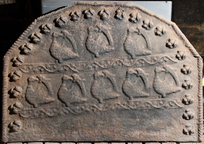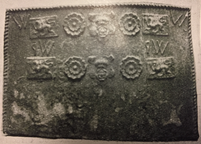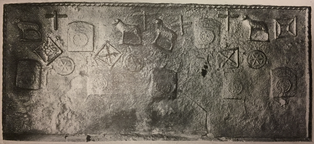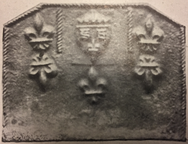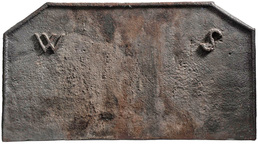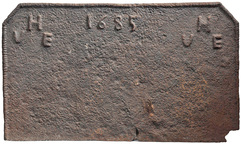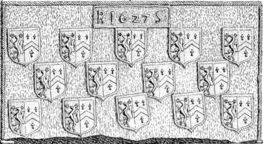-
245
Description: Arched rectangular shaped with narrow shoulders; fillet edging; date in individual numerals across arch.
Notes: A larger version is different in the spacing of the numerals and the proportions of the plate. For another casting of this fireback see J. Every Collection catalogue #20 (Sussex Archaeological Society library, Barbican House, Lewes, Sussex).
Copies of this fireback are known.
Inscription: 1658
- Decoration tags:
- rectangular with round arch (shape)
- rope (edging)
- carved stamps
- individual numbers
- text
Manufactured: in 1658 possibly in the Weald area of England.
Current location: Lytes Cary Manor, Charleton Mackrell, Somerset, England.
Museum number: 254606 (part of the National Trust museum group)
- Attached to series:
- 1658 arched series
- Date only firebacks
-
255
Description: Rectangular; twisted rope edging (top and sides); along upper half of plate, date split with initials in between.
Notes: The initials are likely of William Yalden (d.1674), an ironmaster who was active in north-west Sussex and south-west Surrey where this and other similar firebacks have been noted.
Inscription: 16 WY 68
- Decoration tags:
- rectangular (shape)
- rope (edging)
- individual letters
- individual numbers
- text
Manufactured: in 1668 in the Weald area of England.
Current location: Ramster, Chiddingfold, Surrey, England.
- Attached to series:
- William Yalden series
- Date & initials firebacks
-
1201
Description: Rectangular with five-facetted arched shape; twisted rope edging (top and sides); small flower-bud stamp repeated 23 times inside the edging; across the middle of the fireback, two approximately parallel lines of lengths of vine strip moulding inclined up to the right; between them, five bird stamps, probably swans (a Lancastrian badge), the front of their left wings 'displayed and inverted', and three more swans above the top line of vine strip moulding.
Notes: The stamps are all seen on other firebacks in the same series. The five-facetted arch is seemingly unique. A very similar fireback with minor differences was lot 2630 at Toovey's auction, Washington, West Sussex, 19 Jun 2015.
Copies of this fireback are known.
- Decoration tags:
- multi-facet arched (shape)
- rope (edging)
- carved stamps
- animals
- objects
Manufactured: in the late-16th century possibly at Pounsley Furnace, Framfield in the Weald area of England.
Current location: in private hands, Chiddingstone, Kent, England.
- Attached to series:
- Pounsley series
- Swan series
- Vine strip series
-
262
Description: Rectangular; twisted rope edging (top and sides); top centre, crowned Tudor royal shield (over-pressed) between a leopard passant guardant sinister (on the left) and a leopard passant (on the right); below, crowned shield bearing initials, KH, above a fleur-de-lys, between two crowned roses; below each leopard, a pair of 'imp' figures, the left of each with both arms lowered, the right its right arm raised; right top corner, a crowned rose; left top corner, and uncrowned rose.
Notes: One of the 'Royal' series. Christie's Interiors - Oak Edition, South Kensington (Sale 5369), 4 November 2008, lot 257 (£3,250).
Inscription: KH
Arms: Tudor Royal (prob. Henry VIII)
- Decoration tags:
- rectangular (shape)
- rope (edging)
- carved stamps
- heraldic
- armorial
- royal
- text
- animals
- objects
Manufactured: in the mid-16th century in the Weald area of England.
Current location: not known.
- Attached to series:
- Royal series
-
1196
Description: Quasi-rectangular shape; twisted rope edging (top and sides); 'W' in top corners, between which are a line of five stamps: a 'renaissance' style shield bearing a rose and crown, between two rose stamps, and a rectangular stamp bearing a griffin at each end; below each dragon stamp, a 'W' preceded by a reversed 'P'; below this, the line of five stamps repeated.
Notes: The shield and griffin stamps have been seen on other firebacks, associating them with a common producer; the 'W' may be apotropaic and symbolic of the Virgin Mary. Illustration from Christy 1908 who noted the fireback at Guildford, Surrey.
Inscription: W W / qW qW
- Decoration tags:
- rectangular (shape)
- rope (edging)
- simple stamps
- carved stamps
- individual letters
- heraldic
- apotropaic
- animals
Manufactured: in the mid- to late-16th century in the Weald area of England.
Current location: not known.
- Attached to series:
- Griffin series
-
1194
Description: Rectangular shape; twisted rope or strap edging (top and sides); semi-random arrangement of three stamps interspersed with rope crosses and rope 'squares' with saltires or linked smaller squares within; low centre, a crowned rose-en-soleil stamp repeated, more or less regularly, five times across the width of the fireback; above, four circular butter mould stamps with a hexagonal design, between which are two rope squares with saltires and, to the left, a rope square containing a smaller square with its corners linked to the corners of the outer square; above, a horned sheep standing on a base repeated four times, between which are two crowned rose-en-soleil stamps and four rope crosses, with a square-within-a-square at the right end.
Notes: The rose-en-soleil was the badge of King Edward IV and, thus, a Yorkist symbol. It, together with the butter mould and rope squares, are seen on other firebacks associating them with the same producer/foundry. A ram is the crest of the Gage family of West Firle, for many centuries major landholders in Sussex; it is also the crest of the Clothworkers' Company of London. Formerly at Heringdales/Heronsdale Manor, Waldron, East Sussex, which, however, was not a Gage property. Illustration from Christy 1908.
- Decoration tags:
- rectangular (shape)
- rope (edging)
- simple stamps
- carved stamps
- heraldic
- apotropaic
- animals
- objects
Manufactured: in the mid- to late-16th century possibly at Pounsley Furnace, Framfield in the Weald area of England.
Current location: Wickham Manor, Winchelsea, East Sussex, England.
Museum number: NT/WMF/M/007 (part of the National Trust museum group)
Citation: Gardner, J. S., 1898, 'Iron Casting in the Weald', Archaeologia, 56, 1, pp. 133-164.
- Attached to series:
- Pounsley series
- Food mould stamp firebacks
- Rose-en-soleil series
-
1197
Description: Canted rectangular shape; twisted rope edging (top and sides); top centre, over-pressed crowned shield stamp on a rectangular block, bearing initials KH in Lombardic lettering, above a fleur de lys, the whole between two short vertical lengths of twisted rope, on the outside of each are two fleurs-de-lys, vertically aligned, the lower ones inverted; below the shield, a fifth fleur-de-lys.
Notes: An arrangement of stamps found on a distinctive series of Tudor firebacks of probable Henrician date. Illustration from Christy 1908, who noted it at Riverhall, Wadhurst, Sussex.
- Decoration tags:
- rectangular with canted top corners (shape)
- rope (edging)
- carved stamps
- heraldic
Manufactured: in the mid-16th century in the Weald area of England.
Current location: not known.
- Attached to series:
- Royal series
-
1124
Description: Canted rectangular shape; twisted rope edging (top and sides); initial in each top corner, the S angled to the right.
Notes: Initial letters are in high relief. The Pedestal Auction, Cirencester, 4 Mar 2019, lot 155 (£240).
Inscription: W S
- Decoration tags:
- rectangular with canted top corners (shape)
- rope (edging)
- carved stamps
- individual letters
- text
Manufactured: in the 17th century in England.
Current location: not known.
- Attached to series:
- Initials only firebacks
-
1125
Description: Canted rectangular shape; twisted rope edging (top and sides); date top centre; initials in triad in each corner.
Notes: Damage to bottom right corner. The Pedestal Auction, Cirencester, 4 Mar 2019, lot 154 (£240).
Inscription: VHE [triad] 1685 VHE [triad]
- Decoration tags:
- rectangular with canted top corners (shape)
- rope (edging)
- individual letters
- individual numbers
- text
Manufactured: in 1685 in England.
Current location: not known.
- Attached to series:
- Date & initials firebacks
-
1007
Description: Rectangular; twisted rope edging on top and sides; cavetto-moulded-edged rectangle top centre, enclosing date between initials; 14 shields of Ayloffe impaling Sulyard arranged 5-4-5; Ayloffe: sable, a lion rampant Or, collared gules, between three crosses formy of the second; Sulyard: argent, a chevron gules between three pheons inverted sable.
Notes: William Ayloffe (c1535-1584) of Bretons, Hornchurch, Essex, Justice of the Court of Queen's Bench, married (c1560) Jane, dau. of Sir Eustace Sulyard, of Runwell, Essex. A large number of variants use the same shields; this example, unusually, has the initials RS instead of the more common CT. Illustration from Cowper (1911). Previously at Loddenden, Staplehurst, and before that at Great Cheveney, Marden, Kent.
Inscription: R 1627 S
Arms: Ayloffe impaling Sulyard (William Ayloffe of Bretons, Hornchurch)
- Decoration tags:
- rectangular (shape)
- rope (edging)
- carved stamps
- individual letters
- individual numbers
- armorial
- text
Manufactured: in 1627 possibly at Hawkhurst Furnace in the Weald area of England.
Current location: not known.
- Attached to series:
- Ayloffe series
- Personal armorial firebacks

